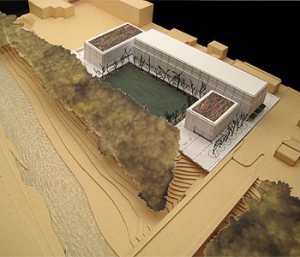UWM Addresses Neighborhood Issues

Proposed UWM Dorm
This was the second of four neighborhood meetings to discuss the proposed UWM resident hall. UWM has been working to increase the number of beds available in a large part because 90% of the students that apply to UWM request student housing and most are turned down. This ability to provide housing for students is important because the retention rate of students living in resident halls is 15% higher than those living off campus. Further, Tom Luljak, Vice Chancellor of University Relations and Communications, explained that another goal is to move students from living in the neighborhood, to students living in student housing. He pointed to the opening of the RiverView resident hall as example of success as their research indicates there are now 300 fewer students living in the neighborhood than there was prior to the opening.
UWM brought a large contingent of staff, UWM Police officers, student C.O.A.S.T. workers, and S.A.F.E. walkers to inform the neighborhood residents of how they handle safety and security issues. They emphasized that UWM resident halls are a controlled environment, that provide an opportunity for students to succeed. Additionally, for safety and security reasons these resident halls include someone working the front desk 24 hours a day, and require guest passes for non-residents to access the building.
Two students from UWM’s S.A.F.E. walker program spoke about their efforts to help improve safety in the neighborhood. This program consists of 25 students who work primarily from 10 PM to 2 AM six days a week to provide security, medical care, and act as trained observers. Additionally, they explained that when the new resident hall opens it will be expanded to include North Avenue.
Only a handful of residents were in attendance, but the one concern that was brought up revolved around student parking. The owner of Judges (located across the street from the Hometown site) was somewhat concerned that the students would have enough parking so they wouldn’t park on the bridge impacting his customer’s parking. His concerns appeared to be addressed by the plan and previous experience with the RiverView dorm because as he said, “you wouldn’t even know that RiverView was open.”
The continued decline in public attendance at these meetings is a telling sign that UWM has put forth significant effort to inform the community on all aspects of this project.


















I was somewhat disappointed with the meeting, because while it focused on safety, it did not focus on how the building would be designed to create a safe environment. They are building right next to a bridge that has homeless sleeping beneath it, and behind their site is a factory, both of which have issues with safety, but they never discussed either. Instead the entire meeting focused on talking about UWM as a whole, and the current safety initiatives and programs that are currently being done. They could have called the meeting the “UWM safety presentation” and avoided any reference to the new dorm, and the presentation would not have changed in a single way.
Anyway, the next meeting should be more informative since it is the transportation meeting, and they can talk about whether a stop light will become necessary, parking needs, and curb cuts, pedestrian crossings, and everything else.
@Matthew The stop light was brought up and they said they were in discussion with the city as to whether or not they would get one. Personally I think over at RiverView they need stop light more than this location but both intersections clearly need improve pedestrian safety measures. As far as homeless sleeping below the bridge yea that didn’t come up but I’m a believer that having 700 more eyes on the street/river will improve the area, not hurt the area as far as safety. As far as the factory no I suppose that wasn’t addressed.
Did anyone mention the mere fact that having 300+ new residents in the area increases safety simply because they are there?
@Fonzie no that wasn’t really discussed but I agree 100%. Simply by adding new “eyes on the street” should be a net positive for safety and security.